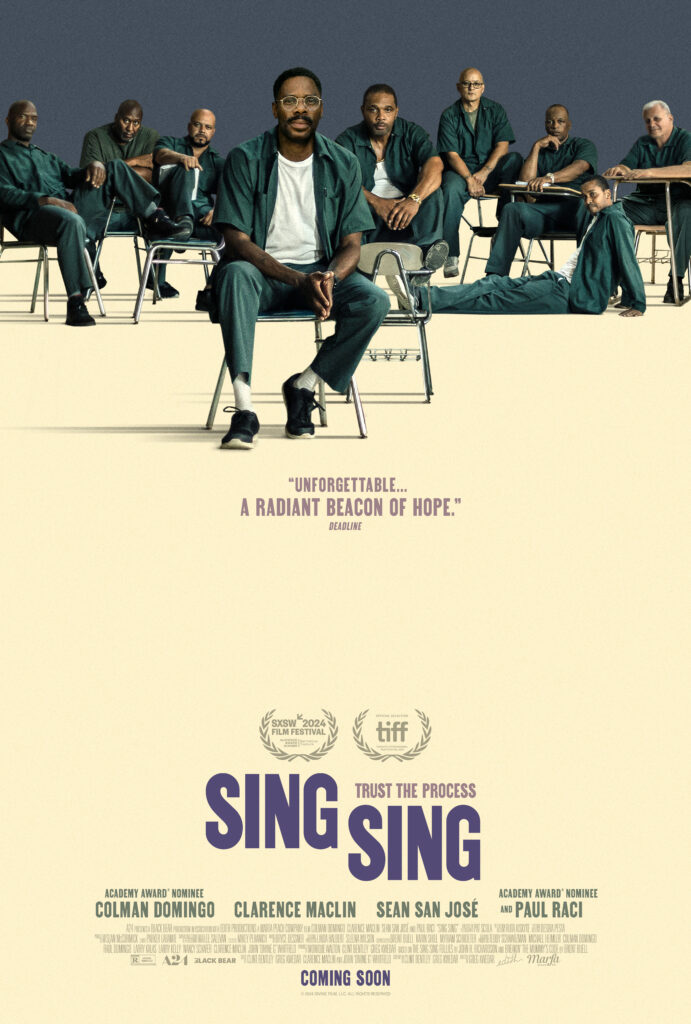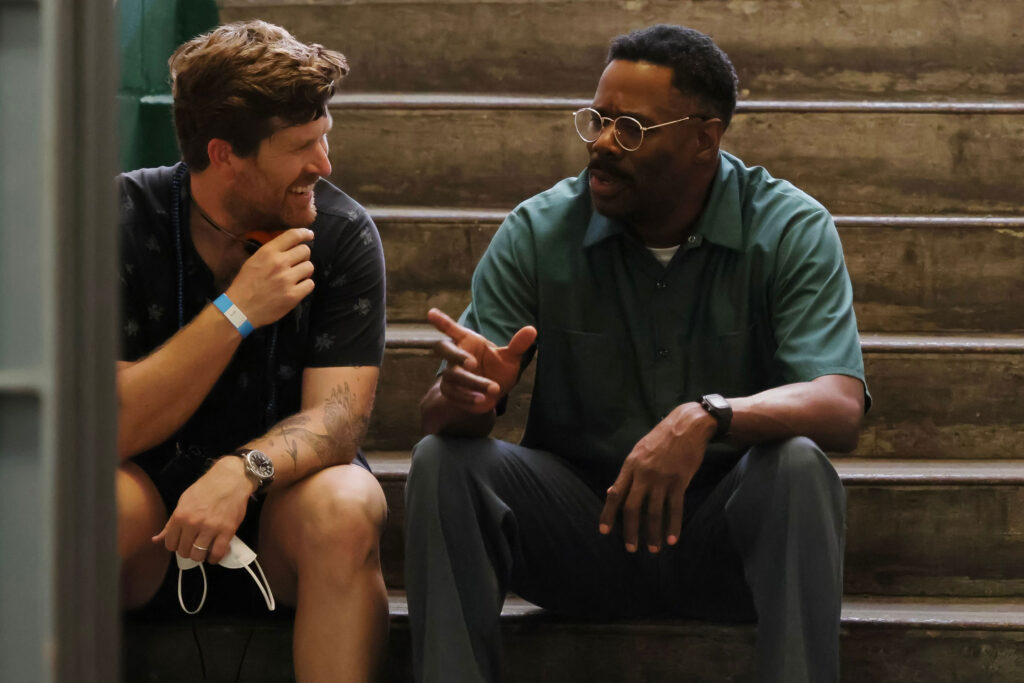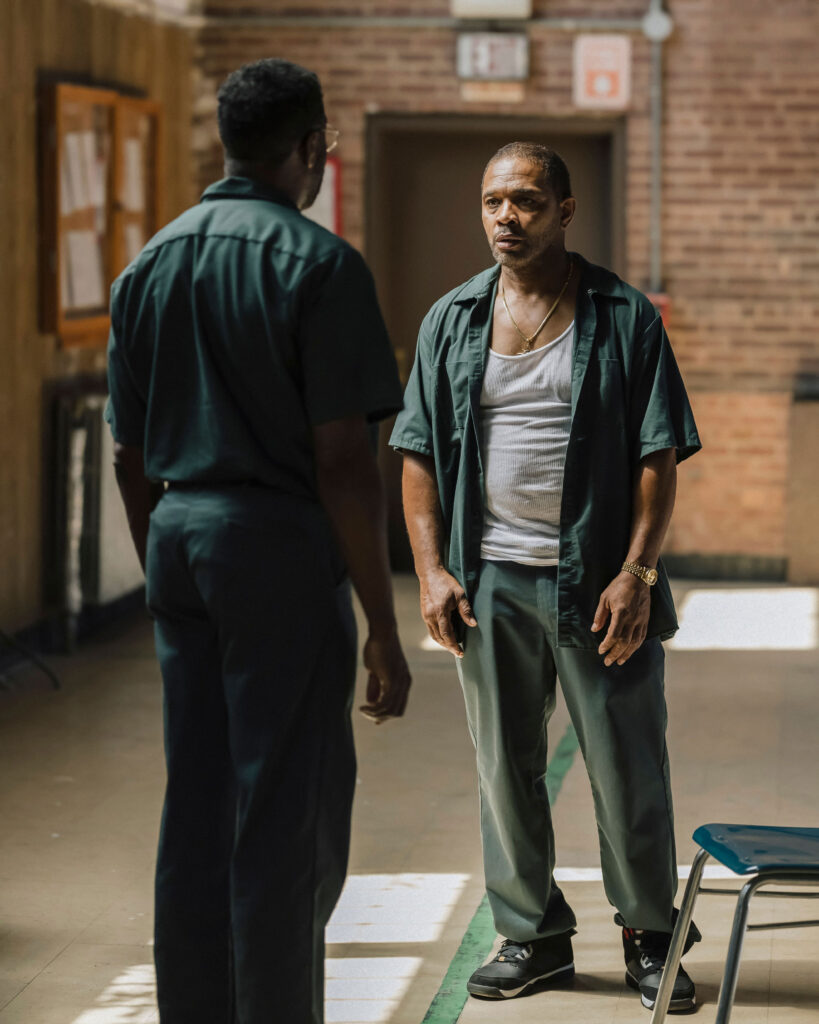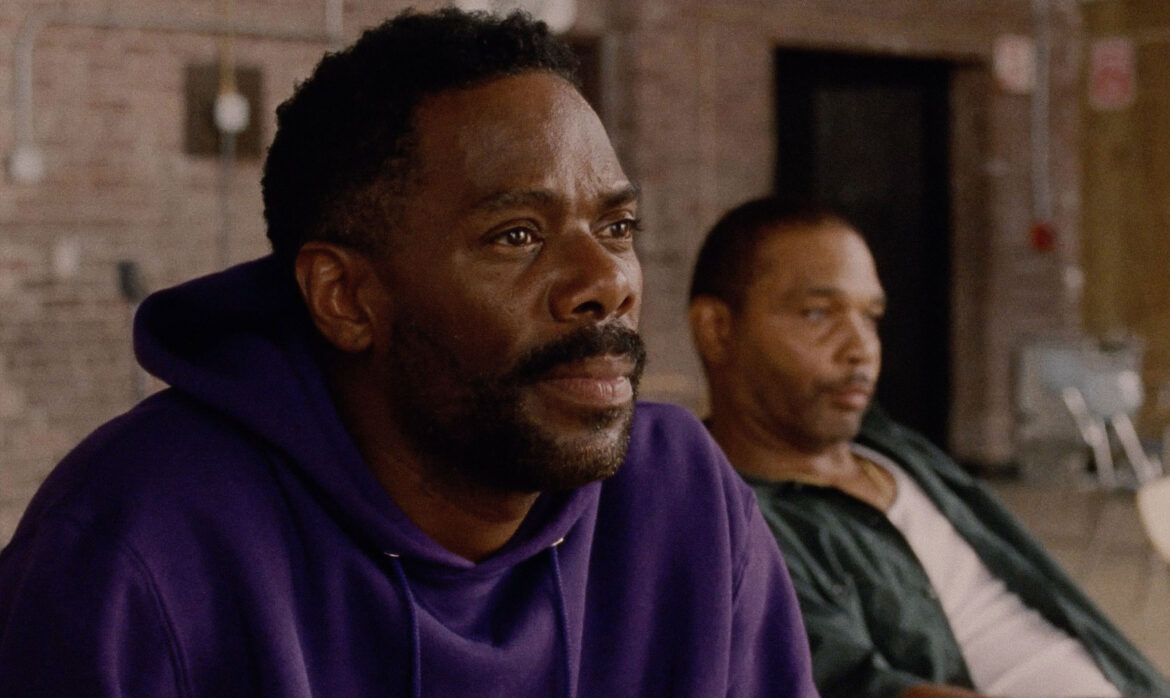By Kirsten Coachman
As creatives, we know firsthand that art’s ability to inspire and transform people knows no boundaries.
“Sing Sing,” the newest film from writer-director Greg Kwedar (“Transpecos”), is the story of a group of men imprisoned at the Sing Sing Correctional Facility in New York who participate in Rehabilitation Through the Arts (RTA). This theater program allows them to connect through shared empathy and performing on stage.

Based on a true story, the film is anchored by Emmy Award winner and recent Oscar nominee Colman Domingo. The actor plays Divine G, who is incarcerated in Sing Sing for a crime he’s not responsible for. As a key member of the prison’s RTA group, Divine G helps with the creative process, from assisting with helming scripts to identifying potential new members like the yard’s resident tough guy Divine Eye, played by Clarence “Divine Eye” Maclin in his feature film debut. What unfolds is the power of art at work, not just in how the men embrace their inner-creative selves as they work on their upcoming performance, but how the RTA provides an outlet for them to be open and genuinely authentic with one another.
An emotional gut punch of a film, “Sing Sing” is easily one of the year’s most impactful, if not most important, films. It’s a story of humanity in an unlikely space that audiences usually are not privy to seeing depicted onscreen. “Sing Sing” is one of those films where audiences should be prepared to be moved in the best way.
Art U News had the opportunity to learn more about the making of “Sing Sing” with actors Domingo, Maclin, Sean San José, and Kwedar last month during the film’s San Francisco press tour stop.
The journey to make “Sing Sing” began with a 2005 Esquire magazine article. In 2016, Kwedar came across “The Sing Sing Follies” by John H. Richardson. The writer details RTA’s production of “Breakin’ the Mummy’s Code,” from the audition process and rehearsals to the opening night performance, taking beats to highlight the stories of various RTA members. When it looked like “Sing Sing” would become a cinematic reality, the director reached out to Domingo.
“I thought it was so fascinating. I thought, ‘Well, this is really awesome,” said Domingo, who got his start doing educational theater in the Bay Area. “I understand the power of theater. We’re (Domingo and San José) two theater practitioners who can actually sit across from you and say theater did save our lives in many ways. If I didn’t have theater, I don’t know where I would be, to be honest. I know it transformed me—helped me in every single way.”
Domingo shared that he wanted to be part of the film, knowing just how tangible the impact of the story and the work being done in the RTA is. “Especially when you learn about the recidivism rate amongst the community,” said Domingo. “Three percent. That’s extraordinary.”
Since the film’s inception, Kwedar shared that there was an instinct to work with and even cast RTA alumni on the film.
“When I went to my first production inside Sing Sing—I saw Shakespeare’s ‘Twelfth Night’—stepping into that and sitting down in that audience, you’re aware of the immense talent,” said Kwedar. “So I always believed that alumni could be a central aspect of the movie and important to the movie.”

The director added: “As the years went by and we leaned further in the process, and we started more directly collaborating with Clarence and Divine G (John Whitfield), and many of the other men, what was a significant part of what was going to be the movie then became the essential part of what the movie was, so that it only deepened, expanded, and became more of a cornerstone of that movie with time.”
RTA alumni make up a good portion of “Sing Sing’s” ensemble cast, including cameos from the real Divine G and the program’s beloved volunteer director Brent Buell, who’s also portrayed by Paul Raci (“Sound of Metal”) in the film. Maclin, a consultant and RTA ambassador, accepted the call to play a fictionalized version of himself onscreen.
“I was glad they wanted me to be in it [laughs]; I was happy,” said Maclin. “It was a great thing all around to be able to get back with my bros. Every time we get together, it’s like a reunion. We were having a great time anyway, so to be able to do something creative and productive, and something that’s gonna serve the world with my bros, it was a great thing.”
When it came to working with Domingo as his scene partner on set, Maclin credited the initial rehearsals over Zoom during the COVID-19 pandemic, which built up his comfort level of working with the Emmy winner.

“The connection was immediate, even through the screen,” shared Maclin. “It was apparent from the beginning—we just clicked. That brother’s spirit is so pure, like, he’s a good dude. And it shines through.”
“[Colman and Paul] could overpower any moment or scene they’re in, and there’s something quite tremendous to both be able to command a moment and be generous at the same time and ensure everyone around them can shine,” said Kwedar. “And that starts from inside a person. That’s a choice you make around your values and what you believe about art and the artistic process and the realization of inside this facility that we’re shooting, we’re all sweating the same sweat [laughs].”
This spirit that Maclin and Kwedar speak of about Domingo comes through in his performance. In the film, Divine G spends much of his time giving toward others, whether working on a script or looking up information in the law library to help a fellow man with their parole hearing. Yet, he also has his moments of being more quiet and reserved. It’s through his friendship and connection with Mike Mike (San José) that offers emotional respite for both men.
And who better to play onscreen best friends with than your own best friend of over 30 years?
“I wanted Sean to be a part of this ‘cause I know what he brings as an artist. Did I know what he was gonna bring as this character, Mike Mike? Not exactly, but I knew he had the faculty to do a lot of things,” said Domingo. “It wasn’t like, ‘Oh, I want to play these notes.’ I’m like, I have no idea, but I need your help. And I need you to bring all your superpowers that you’ve had for many years I’ve known you into this process that feels like we’re creating something new, a film that has not been done.”
“I look at this obviously as a gift to get to do this, but I also look at it as another chapter in a constant set of creativity with this person,” said San José, the Artistic Director of the Magic Theatre in San Francisco. “But it’s also like, friendship is one thing. Like, I’ll get to play best friends, you know, back and forth. They can tell jokes to each other. They can be intimate. But I have to say, I know no one else in the world who believes in me the way that Colman believes in me. And that’s the ultimate friendship.”
One of Domingo and San José’s shared scenes is also one of the most affecting moments of the film, where Divine G and Mike Mike have a conversation from their respective cells. Domingo described the scene as “a listening exercise.”
“I always think it was like those 4 a.m. conversations where you’re so opened up, and there’s something that you can’t even see happening to one character,” said Domingo. “And even I didn’t know what Sean was playing on that or how he’s working on two levels over there. Something is deeply affecting him in every single way. And his language still had a brightness to it. … I feel like the scene is working on so many different levels.”
Shooting the film, and this scene especially, in an authentic setting—a decommissioned prison—proved useful for the actors. “The first breath, the air is literally different in there,” commented San José.
It also allowed them to hone in on the film’s underlying theme.
“The film is about intimacy,” said San José. “Human intimacy, you know, non-romantic male intimacy of people that have been hardened by life.”
To which Domingo noted: “Which is radical as f–k.”
“Sing Sing” is now playing in select theaters.
